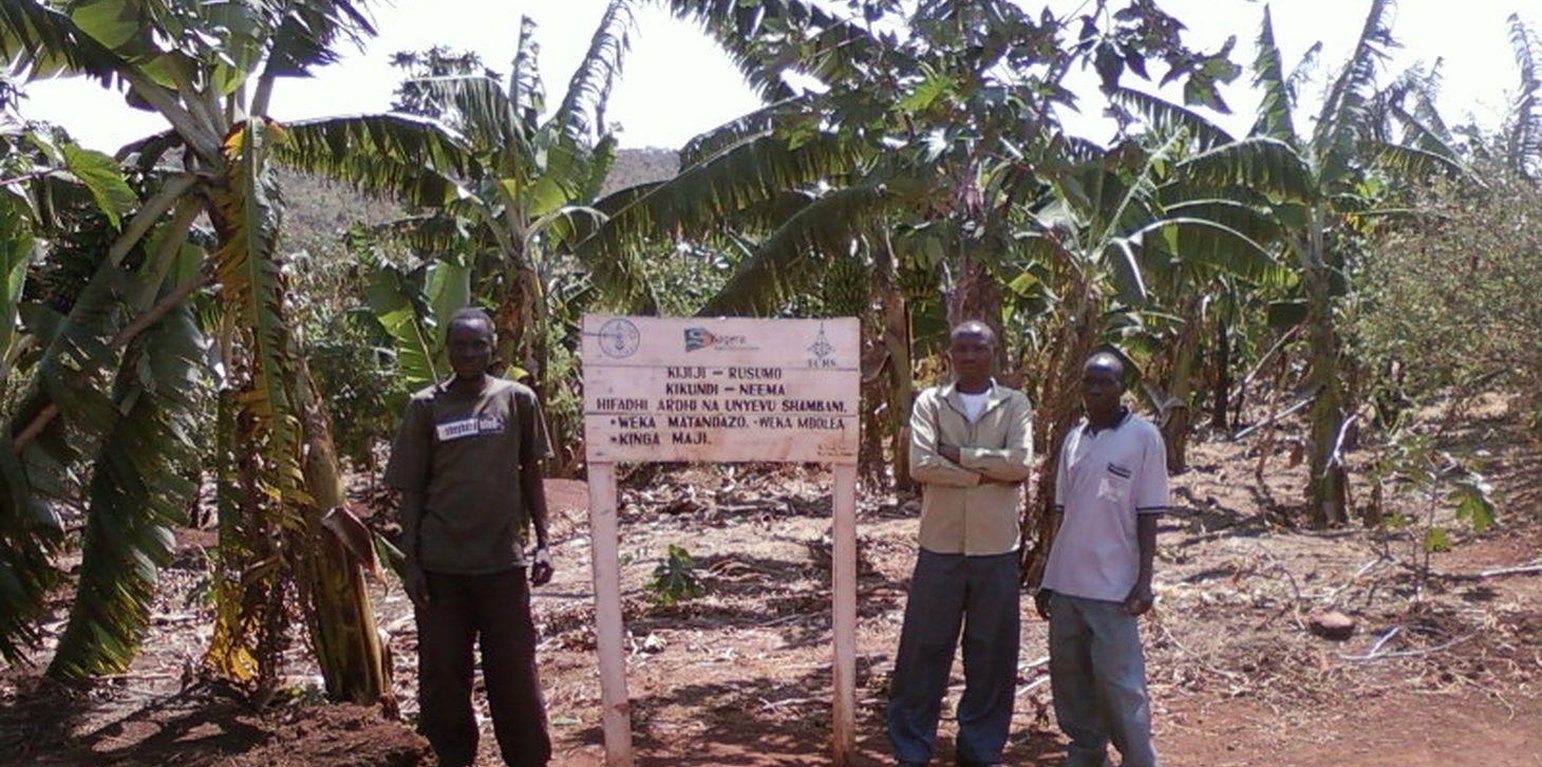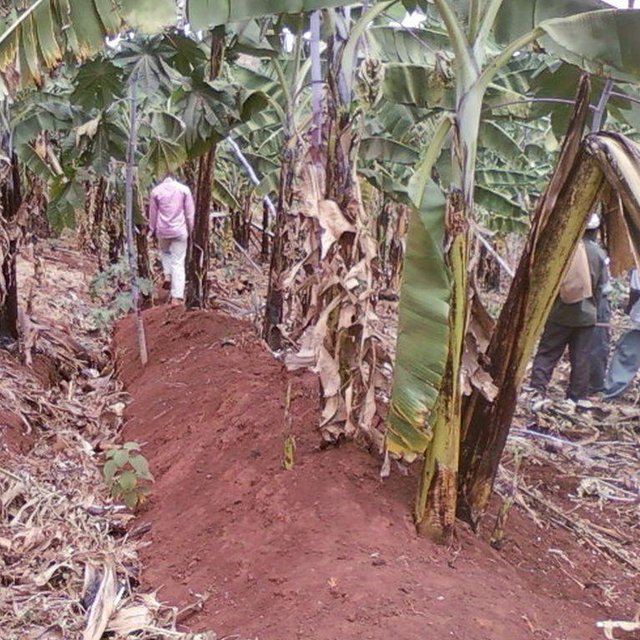



The contour band stabilized with cajanus cajan and pineapples in the composite manures and trushline application technology is the digging of a 0.6m wide by 0.6m deep along the demarcated contour line, while two rows of cajanus cajan planted along the band spaced at 0.3m and two rows of pineapples at alternating band spaced at 0.3m. The overall purpose of the technology is to reduce soil erosions while increasing soil water infiltration and retaining soil water moisture. The technology is applied perennial cropland in the sub humid climatic zone on the gentle to moderate slope, loam soils with medium soil depth. The technology is done manually using hand hoes and mattock in a mixed production system, land owned individually not titled while the total cost to implement a technology on 0.2ha in the banana field was calculated to be US$ …..
The purpose is to increase land productivity, improve livelihood as well as improved ecosystem and micro climate. This should be attained by improving water use efficiency, soil fertility inprovement to increase crop productivity and generating incomes.
The establishment procedures require the determination of the slope and demarcation of a contour line using a tool known as A-frame. This is done manually during the rainy season. The digging and excavation of the soils is done at the end of harvesting annual crops (bean and maize) using hand hoes manually. The cajanus cajan seeds are sown in two rows along the band and the next band is planted with two rows of pinepples at 0.3m between rows as well as between plants. The shallow ditch measuring 0.6m by 0.6m is excavated at the centre of four banana stools to collect crop residues to decompose and apply them. Old banana stools are up rooted at the end of rain season while measurements and digging of holes done. The spacing is 3.6m by 3.6m for the planted medium variety. The hole measurements is 0.6m width by 0.6m length by 0.3m depth. The farmyard manures are mixed with top soils and covered in the hole for three months before planting. The planting is done before the onset of rainfalls. The dry grass mulch is applied across the slope with a thickness of 0.15m at the onset of rainfalls.
The maintenance procedures require the remove of sedments at the end of rainseason done manually using spades. The trimming of cajanus cajan and pineapples are done manually during the harvesting season. Desuckering and detrushing of banana plants are done twice after harvesting annual crops while grass mulch followed.
Average annual rainfall (750 to 1,000)mm, Altitude (m a.s.l.) (1,000 -1,500)m Landform is hill slope to foot slope, Soil depth (>20 cm) shallow about 20%, (20-50cm) medium about 60% and (50-80cm) deep about 20%, Soil water storage capacity: medium, Soil texture: medium (loam), Soil fertility: low, Topsoil organic matter: medium (1-3%) and Soil drainage/infiltration: medium. Cropland per household is 2-5 ha, Land user are Individual / household, Small scale land users, common / average land users, men and women. Population density: 200-500 persons/km2, Annual population growth: < 0.5%, Land ownership: individual, not titled Land use rights: individual, Water use rights: open access (unorganised) Relative level of wealth: rich, which represents 5% of the land users; 21% of the total area is owned by rich land users average, which represents 64% of the land users; 64% of the total area is owned by average land users poor, which represents 21% of the land users; 5% of the total area is owned by poor land users Market orientation: mixed (subsistence and commercial) Mechanization: manual labour
สถานที่: Ngara District Council, Tanzania, แทนซาเนีย
ตำนวนการวิเคราะห์เทคโนโลยี:
การเผยแพร่ของเทคโนโลยี: กระจายไปอย่างสม่ำเสมอในพื้นที่ (approx. < 0.1 ตร.กม.(10 เฮกตาร์))
In a permanently protected area?:
วันที่ในการดำเนินการ: น้อยกว่า 10 ปี (ไม่นานนี้)
ประเภทของการแนะนำ







| ปัจจัยนำเข้า | หน่วย | ปริมาณ | ค่าใช้จ่ายต่อหน่วย (TShs.) | ค่าใช้จ่ายทั้งหมดต่อปัจจัยนำเข้า (TShs.) | %ของค่าใช้จ่ายที่ก่อให้เกิดขึ้นโดยผู้ใช้ที่ดิน |
| แรงงาน | |||||
| labour | ha | 1.0 | 1696.85 | 1696.85 | |
| อุปกรณ์ | |||||
| tools | ha | 1.0 | 4.71 | 4.71 | 100.0 |
| วัสดุด้านพืช | |||||
| seedlings | ha | 1.0 | 433.89 | 433.89 | |
| ค่าใช้จ่ายทั้งหมดของการจัดตั้งเทคโนโลยี | 2'135.45 | ||||
| Total costs for establishment of the Technology in USD | 1.26 | ||||
| ปัจจัยนำเข้า | หน่วย | ปริมาณ | ค่าใช้จ่ายต่อหน่วย (TShs.) | ค่าใช้จ่ายทั้งหมดต่อปัจจัยนำเข้า (TShs.) | %ของค่าใช้จ่ายที่ก่อให้เกิดขึ้นโดยผู้ใช้ที่ดิน |
| แรงงาน | |||||
| labour | ha | 1.0 | 205.88 | 205.88 | 100.0 |
| ค่าใช้จ่ายทั้งหมดของการบำรุงรักษาสภาพเทคโนโลยี | 205.88 | ||||
| Total costs for maintenance of the Technology in USD | 0.12 | ||||
จำนวนก่อน SLM: 5
หลังจาก SLM: 24
banana
costs of manures, certified banana suckers
sales of excess banana, beans and pinepples.
จำนวนก่อน SLM: 0
หลังจาก SLM: 1
sales of beans and pinepples
additonal activities at the sama season.
Household devoted labor to invrease productivity.
working as group on the training sites.
private service providers participation in project implementation.
group members attended FFS
จำนวนก่อน SLM: 0
หลังจาก SLM: 25
group formation considered gender equality
The technology maturity age of 18 months is too young to measure the livelihood indicators, though a positive perception is at hand.
contour
contour
grass mulch
grass mulch
grass mulch
grass mulch to prevent soil erosion
cajanus cajan
composite manures application
grass mulch
Composite manure utilization
The area is too small to show the effects.
grass mulch retrds water run-off